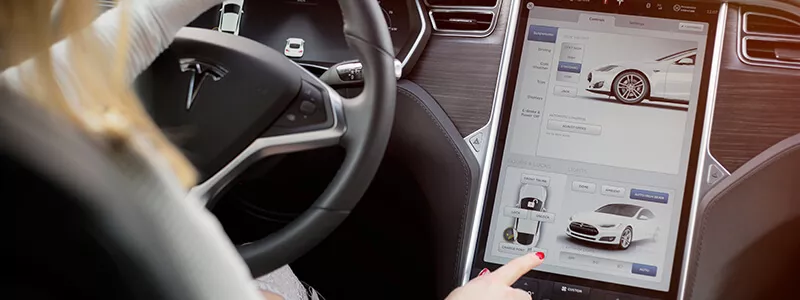Consumers are more empowered than ever before.
When the customer is king, companies must continuously seek ways to bolster their customer experience strategy. They must not only cater to customers’ needs, but also anticipate them.
In 2017, 6 companies stood out for introducing new services, product features, and offerings to provide an excellent customer experience.
 Online retail giant Amazon is widely recognized as a leader in customer service. With features such as same-day delivery and instant check-out, Amazon places a premium on immediacy. Amazon launched several new offerings in 2017 to emphasize the role of convenience in its customer experience strategy.
With “Amazon Key,” couriers can unlock your door and deliver packages safely inside your home, whether or not you’re there.
After verifying the delivery, couriers use an app to unlock a smart lock on the front door. Inside, Amazon Cloud Cam monitors the delivery to protect customers’ privacy and safety, according to The Verge.
Online retail giant Amazon is widely recognized as a leader in customer service. With features such as same-day delivery and instant check-out, Amazon places a premium on immediacy. Amazon launched several new offerings in 2017 to emphasize the role of convenience in its customer experience strategy.
With “Amazon Key,” couriers can unlock your door and deliver packages safely inside your home, whether or not you’re there.
After verifying the delivery, couriers use an app to unlock a smart lock on the front door. Inside, Amazon Cloud Cam monitors the delivery to protect customers’ privacy and safety, according to The Verge.
 Business travel can be a headache. There’s the planning, booking, keeping track of expenses — all while ensuring compliance with company policies. Then there is the trip itself. Deem, founded in 1999,works to simplify this process.
Deem is a mobile and cloud-based corporate travel booking and management company. The Deem Work Fource platform leverages machine learning, artificial intelligence and predictive analytics for booking, managing costs, and other travel agency services.
Business travel can be a headache. There’s the planning, booking, keeping track of expenses — all while ensuring compliance with company policies. Then there is the trip itself. Deem, founded in 1999,works to simplify this process.
Deem is a mobile and cloud-based corporate travel booking and management company. The Deem Work Fource platform leverages machine learning, artificial intelligence and predictive analytics for booking, managing costs, and other travel agency services.
 Slack, the cloud-based collaboration platform, in December teamed up with Collaborative Marketing Solutions LLC to introduce a new integrated, virtual meeting solution.
The partnership will give Slack users an improved digital customer experience by giving them access to more than 100 collaboration tools. With virtual Instant Team Meetings, Slack’s 9 million weekly active users will be able to use video, whiteboards, screen sharing, presentations, and audience polls, among other apps, to make communication simpler and more efficient.
Slack, the cloud-based collaboration platform, in December teamed up with Collaborative Marketing Solutions LLC to introduce a new integrated, virtual meeting solution.
The partnership will give Slack users an improved digital customer experience by giving them access to more than 100 collaboration tools. With virtual Instant Team Meetings, Slack’s 9 million weekly active users will be able to use video, whiteboards, screen sharing, presentations, and audience polls, among other apps, to make communication simpler and more efficient.
 Music-streaming service Spotify contains millions of songs to suit all tastes. In addition to its vast music warehouse, Spotify has made its personalized playlists a key part of its customer experience strategy.
In May, Spotify acquired AI startup Niland to enhance its music search and recommendation capabilities, according to Tech Crunch. Niland’s music and search discovery engines are powered by deep learning and machine listening algorithms. Adding its technology enables Spotify to give users an even more tailored listening experience.
Music-streaming service Spotify contains millions of songs to suit all tastes. In addition to its vast music warehouse, Spotify has made its personalized playlists a key part of its customer experience strategy.
In May, Spotify acquired AI startup Niland to enhance its music search and recommendation capabilities, according to Tech Crunch. Niland’s music and search discovery engines are powered by deep learning and machine listening algorithms. Adding its technology enables Spotify to give users an even more tailored listening experience.
 Few CEOs willingly take customer questions and complaints into their own hands. Customer support teams are responsible for that.
However, Tesla and SpaceX CEO Elon Musk proved that no one — not even top executives — are too busy or too far removed to help customers. Moreover, Musk understands that communicating with customers, even regarding complaints, actually strengthens the company’s brand.
Few CEOs willingly take customer questions and complaints into their own hands. Customer support teams are responsible for that.
However, Tesla and SpaceX CEO Elon Musk proved that no one — not even top executives — are too busy or too far removed to help customers. Moreover, Musk understands that communicating with customers, even regarding complaints, actually strengthens the company’s brand.
 Too often, Twitter users have been victims of harassment, threats, and other forms of abuse. Now the company is hoping a new set of policies will help keep the platform safe and improve the digital customer experience.
In December, Twitter announced it will enforce new rules for regulating hate speech and threats among its 330 million active monthly users.
Under the new rules, Twitter will eliminate accounts that are associated with groups that promote violence, whether online or offline. Users will also be banned for posting tweets that celebrate “any violent act in a manner that may inspire others to replicate it or any violence where people were targeted because of their membership in a protected group,” Tech Crunch reported.
On a first offense, Twitter will remove a tweet if it doesn’t abide by the company’s rules. Repeat offenders will be permanently banned.
Additionally, the policy applies to users’ bios, display names, and usernames.
Too often, Twitter users have been victims of harassment, threats, and other forms of abuse. Now the company is hoping a new set of policies will help keep the platform safe and improve the digital customer experience.
In December, Twitter announced it will enforce new rules for regulating hate speech and threats among its 330 million active monthly users.
Under the new rules, Twitter will eliminate accounts that are associated with groups that promote violence, whether online or offline. Users will also be banned for posting tweets that celebrate “any violent act in a manner that may inspire others to replicate it or any violence where people were targeted because of their membership in a protected group,” Tech Crunch reported.
On a first offense, Twitter will remove a tweet if it doesn’t abide by the company’s rules. Repeat offenders will be permanently banned.
Additionally, the policy applies to users’ bios, display names, and usernames.
Deliver the best customer experience and increase retention.
Standout Companies That Delivered a Great Customer Experience in 2017
How Amazon is Raising Convenience to New Heights
 Online retail giant Amazon is widely recognized as a leader in customer service. With features such as same-day delivery and instant check-out, Amazon places a premium on immediacy. Amazon launched several new offerings in 2017 to emphasize the role of convenience in its customer experience strategy.
With “Amazon Key,” couriers can unlock your door and deliver packages safely inside your home, whether or not you’re there.
After verifying the delivery, couriers use an app to unlock a smart lock on the front door. Inside, Amazon Cloud Cam monitors the delivery to protect customers’ privacy and safety, according to The Verge.
Online retail giant Amazon is widely recognized as a leader in customer service. With features such as same-day delivery and instant check-out, Amazon places a premium on immediacy. Amazon launched several new offerings in 2017 to emphasize the role of convenience in its customer experience strategy.
With “Amazon Key,” couriers can unlock your door and deliver packages safely inside your home, whether or not you’re there.
After verifying the delivery, couriers use an app to unlock a smart lock on the front door. Inside, Amazon Cloud Cam monitors the delivery to protect customers’ privacy and safety, according to The Verge.
A Great Customer Experience Demands Minimal Customer Effort
Amazon is so good at providing an excellent shopping experience because it understands that customers want to devote minimal time and energy to the process. The company’s speedy delivery system satisfies customers’ demands for immediacy. However, people often aren’t home when packages arrive. Leaving boxes outside unattended makes them vulnerable for theft. Asking customers to pick them up at the post office would be adding to their workload. With the right security precautions in place, Amazon Key makes online shopping smoother and more painless than ever before. This definitely raised the definition of a great customer experience to a new level in 2017.Deem Makes Business Travel a Breeze
 Business travel can be a headache. There’s the planning, booking, keeping track of expenses — all while ensuring compliance with company policies. Then there is the trip itself. Deem, founded in 1999,works to simplify this process.
Deem is a mobile and cloud-based corporate travel booking and management company. The Deem Work Fource platform leverages machine learning, artificial intelligence and predictive analytics for booking, managing costs, and other travel agency services.
Business travel can be a headache. There’s the planning, booking, keeping track of expenses — all while ensuring compliance with company policies. Then there is the trip itself. Deem, founded in 1999,works to simplify this process.
Deem is a mobile and cloud-based corporate travel booking and management company. The Deem Work Fource platform leverages machine learning, artificial intelligence and predictive analytics for booking, managing costs, and other travel agency services.
New Strategic Partnerships Positioned Deem to Boost their Customer Experience
Deem’s customer experience strategy focuses on taking the work out of employees’ hands by offering tools that automate travel booking and expense management processes. The company established several key partnerships in 2017 to expand its functionality. In November, Deem partnered with Apptricity Corporation to integrate Apptricity’s travel booking and spend management solutions into its suite of offerings. The partnership improves Deem’s customer experience by further simplifying the travel expense management process. Deem also forged a partnership with Lyft, through which it integrated ride sharing services into its ground transportation software. This move improves the company’s customer experience by eliminating the need for travelers to order Lyft rides separately from other travel reservations. Now, all of these arrangements can be made at once in advance.Slack Pushes Virtual Communication Tools One Step Further
 Slack, the cloud-based collaboration platform, in December teamed up with Collaborative Marketing Solutions LLC to introduce a new integrated, virtual meeting solution.
The partnership will give Slack users an improved digital customer experience by giving them access to more than 100 collaboration tools. With virtual Instant Team Meetings, Slack’s 9 million weekly active users will be able to use video, whiteboards, screen sharing, presentations, and audience polls, among other apps, to make communication simpler and more efficient.
Slack, the cloud-based collaboration platform, in December teamed up with Collaborative Marketing Solutions LLC to introduce a new integrated, virtual meeting solution.
The partnership will give Slack users an improved digital customer experience by giving them access to more than 100 collaboration tools. With virtual Instant Team Meetings, Slack’s 9 million weekly active users will be able to use video, whiteboards, screen sharing, presentations, and audience polls, among other apps, to make communication simpler and more efficient.
Great B2B Customer Experience Means Catering to Employees’ Needs
When an entire business is your customer, your No. 1 priority should be making its employees’ lives easier. Slack gets it. The platform contains all of the tools and apps necessary for fast and seamless communication. New virtual capabilities take this one step further. Slack’s partnership with CMS means customers within brick-and-mortar offices and beyond can communicate with ease. For companies that value collaboration, virtual meetings present the opportunity to ensure consistent communication across disparate teams and remote employees.Spotify’s Customer Experience Strategy Puts the User at the Center
 Music-streaming service Spotify contains millions of songs to suit all tastes. In addition to its vast music warehouse, Spotify has made its personalized playlists a key part of its customer experience strategy.
In May, Spotify acquired AI startup Niland to enhance its music search and recommendation capabilities, according to Tech Crunch. Niland’s music and search discovery engines are powered by deep learning and machine listening algorithms. Adding its technology enables Spotify to give users an even more tailored listening experience.
Music-streaming service Spotify contains millions of songs to suit all tastes. In addition to its vast music warehouse, Spotify has made its personalized playlists a key part of its customer experience strategy.
In May, Spotify acquired AI startup Niland to enhance its music search and recommendation capabilities, according to Tech Crunch. Niland’s music and search discovery engines are powered by deep learning and machine listening algorithms. Adding its technology enables Spotify to give users an even more tailored listening experience.
Every Listening Experience is “Made Just for You”
At the heart of Spotify’s customer experience strategy is the understanding that users’ music preferences are deeply individual. It aims to deliver each user’s favorite songs, as well as new tunes he or she might like, on a daily basis. By integrating users’ established favorites with tailored recommendations, listeners are never bored. Moreover, they keep coming back for more. Spotify’s “Made For You” feature is core to its customer experience strategy. The offering automatically compiles daily mixes and recommendations. Its “2017 Wrapped” offering, which made its debut in December, chronicles users’ most listened to songs of the year. Artists also enjoy a highly personalized customer experience on the platform. “2017 Wrapped” shows artists customized micro-sites with key pieces of listener data. They can see when their songs got the most listens, total unique listeners, the number of times users streamed their songs, and the amount of time listeners spend on each song, according to Billboard.Tesla CEO Elon Musk Proves Great Customer Service is Everyone’s Responsibility
 Few CEOs willingly take customer questions and complaints into their own hands. Customer support teams are responsible for that.
However, Tesla and SpaceX CEO Elon Musk proved that no one — not even top executives — are too busy or too far removed to help customers. Moreover, Musk understands that communicating with customers, even regarding complaints, actually strengthens the company’s brand.
Few CEOs willingly take customer questions and complaints into their own hands. Customer support teams are responsible for that.
However, Tesla and SpaceX CEO Elon Musk proved that no one — not even top executives — are too busy or too far removed to help customers. Moreover, Musk understands that communicating with customers, even regarding complaints, actually strengthens the company’s brand.
How Elon Musk Uses Social Media to Safeguard the Customer Experience
In November, a passenger asked him on Twitter where the mirror on the passenger sun visor was in her parents’ Tesla. The young woman tweeted Musk, asking him if leaving the passenger side mirror out was “intentional or an oversight,” according to CNBC. Musk tweeted back and assured her the mirror was there, and gave her directions to find it. “Woo thanks!” she replied. This isn’t the first time Musk helped customers via Twitter. He has even implemented new company policies based off customers’ tweeted complaints. For example, in August a Tesla owner requested via Twitter a feature that would raise the steering wheel and move the driver’s seat back once the car is in park. The same day, Musk replied, “Good point. We will add that to all cars in one of the upcoming software releases.” And in December 2016, a frustrated driver tweeted his frustration about fellow Tesla owners who leave their cars in superchargers, even after they are fully charged. Later that day, Musk answered, “You’re right, this is becoming an issue. Supercharger spots are meant for charging, not parking. Will take action soon.” Six days later, Tesla released a new policy that imposes fines for drivers who allow their cars to idle in chargers, according to Inc. As a customer, receiving personal attention from a CEO is rare. This experience becomes even more special when your conversation results in new company policies.Twitter Implements New Rules to Protect Users from Abuse
 Too often, Twitter users have been victims of harassment, threats, and other forms of abuse. Now the company is hoping a new set of policies will help keep the platform safe and improve the digital customer experience.
In December, Twitter announced it will enforce new rules for regulating hate speech and threats among its 330 million active monthly users.
Under the new rules, Twitter will eliminate accounts that are associated with groups that promote violence, whether online or offline. Users will also be banned for posting tweets that celebrate “any violent act in a manner that may inspire others to replicate it or any violence where people were targeted because of their membership in a protected group,” Tech Crunch reported.
On a first offense, Twitter will remove a tweet if it doesn’t abide by the company’s rules. Repeat offenders will be permanently banned.
Additionally, the policy applies to users’ bios, display names, and usernames.
Too often, Twitter users have been victims of harassment, threats, and other forms of abuse. Now the company is hoping a new set of policies will help keep the platform safe and improve the digital customer experience.
In December, Twitter announced it will enforce new rules for regulating hate speech and threats among its 330 million active monthly users.
Under the new rules, Twitter will eliminate accounts that are associated with groups that promote violence, whether online or offline. Users will also be banned for posting tweets that celebrate “any violent act in a manner that may inspire others to replicate it or any violence where people were targeted because of their membership in a protected group,” Tech Crunch reported.
On a first offense, Twitter will remove a tweet if it doesn’t abide by the company’s rules. Repeat offenders will be permanently banned.
Additionally, the policy applies to users’ bios, display names, and usernames.

